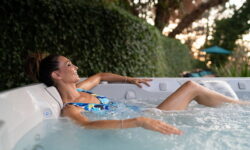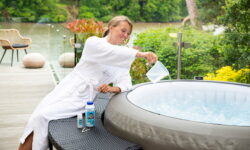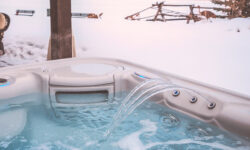You’re pondering, “Can I add hot tub chemicals to cold water?” Well, you’re not alone. It’s a common question among hot tub owners.
Yes, you can add hot tub chemicals to cold water. However, it’s important to note that these chemicals may take longer to dissolve and distribute evenly throughout the water when it’s cold. It’s always best to follow the manufacturer’s instructions for the specific chemicals you’re using.
This article will guide you through the impact of water temperature on chemical effectiveness, provide guidelines for use in cold water, and weigh the pros and cons.
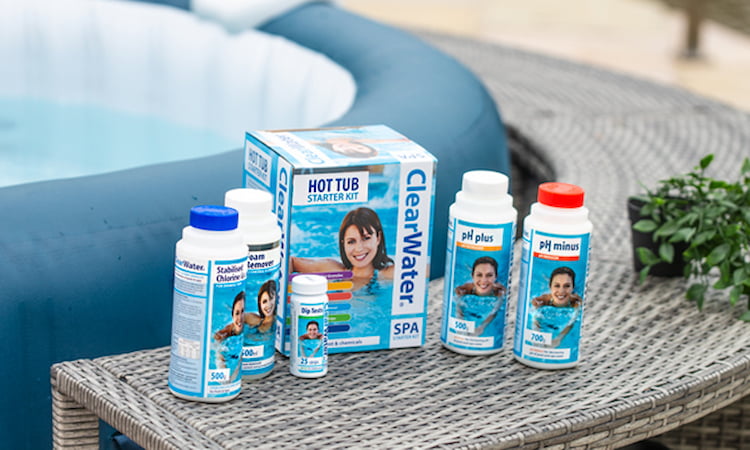
Quick Navigation
Understanding Hot Tub Chemicals
You’ll need to understand that hot tub chemicals are essential for maintaining the cleanliness and safety of your spa’s water. These chemicals serve as sanitizers, helping to kill bacteria and other harmful microorganisms that can thrive in warm water.
You’re probably familiar with chlorine and bromine, the two most common chemicals used in hot tubs. Chlorine is a powerful sanitizer and oxidizer, meaning it not only kills bacteria but also helps to break down organic matter, such as sweat or body oils.
Bromine, on the other hand, works similarly but is less harsh on skin and eyes, making it a popular choice for many hot tub owners.
Besides these sanitizers, you’ll also need to use other chemicals to regulate the pH level of your hot tub water. Maintaining a balanced pH level is crucial for the effectiveness of sanitizers and for the overall health of your hot tub.
The Impact of Water Temperature
Your hot tub’s water temperature significantly influences the effectiveness of the chemicals you add. Although it may seem like a minor detail, it’s crucial to understand how various temperatures can impact the chemical balance.
When the water is too cold, chemicals don’t dissolve or react as effectively. They might take longer to disperse and start working, which could leave your hot tub unprotected against bacteria and algae for an extended period.
Related Read: Can You Make a Hot Tub Cool in the Summer?
On the other hand, if the water is too hot, chemicals can become overly reactive, dissipating quicker than they should. This, too, can lead to an imbalance, as you’ll need to add more chemicals more frequently, resulting in higher maintenance costs.
Here are some key points to remember:
- Always check the manufacturer’s instructions for the ideal water temperature for chemical application.
- Monitor your hot tub’s temperature regularly to ensure it’s within an optimal range.
- Adjust the amount of chemicals you add based on the temperature, adding more if it’s hotter and less if it’s colder.
Guidelines for Using Chemicals in Cold Water
Despite the challenges, it’s possible to add chemicals to your hot tub even when the water is cold, but you’ll need to follow a few key guidelines to ensure effectiveness.
Firstly, always make sure to pre-dissolve granular chemicals before adding them to the tub. Cold water doesn’t dissolve substances as efficiently as hot water, so this step is vital. Mix the chemicals in a bucket of warm water until they fully dissolve, then slowly pour the mixture into the tub.
Next, consider the type of chemicals you’re using. Some, like chlorine, work less efficiently in cold water, so you might need to use a higher concentration. Others, like bromine, are less affected by temperature changes and can be used at the usual dose.
Lastly, be patient and give the chemicals time to work. Cold water slows down chemical reactions, so it might take a bit longer for your hot tub to reach the desired chemical balance. Regularly test the water to make sure it’s safe and comfortable for use.
Pros and Cons of Cold Water Chemical Addition

Adding chemicals to cold hot tub water comes with its own set of advantages and drawbacks that you should consider.
On the plus side, adding chemicals to cold water can often be easier as it gives you more time to evenly disperse throughout the tub. The cooler temperature reduces the rate at which the chemicals dissolve, allowing for a more controlled and thorough mix.
However, this method isn’t without its downsides. Here are a few key points to keep in mind:
- The effectiveness of certain chemicals can be reduced in cold water. This could mean you’ll need to use more products to achieve the desired results, increasing your maintenance costs.
- Cold water can make it harder to dissolve certain chemicals, which may lead to undissolved residues in your hot tub.
- The time it takes for the chemicals to fully dissolve and start acting can be longer in cold water. This could delay the time you can safely use your hot tub.
Expert Tips for Maintaining Your Hot Tub
Often, managing the balance of chemicals in your hot tub, whether hot or cold, can seem daunting, but with some expert advice, you’ll find it’s easier than you think.
Regular maintenance is key to keeping your hot tub in optimal condition and ensuring it’s safe to use. Here are some expert tips that can help.
Consider the following table, designed to offer you some professional guidance in maintaining your hot tub:
| Task | Frequency | Importance |
|---|---|---|
| Water Testing | Weekly | Ensures balance of chemicals |
| Clean Filters | Monthly | Prevents clogs and improves efficiency |
| Draining Tub | Every 3-4 months | Freshens water and removes buildup |
| Surface Cleaning | As needed | Prevents stains and maintains appearance |
Testing your water weekly is crucial to maintain the correct chemical balance. Cleaning filters monthly is necessary to keep your tub running efficiently.
Draining and refilling your tub every 3-4 months helps keep the water fresh and free of excess buildup. Surface cleaning should be done as needed to avoid stains and keep your tub looking new.
Frequently Asked Questions
After adding chemicals to your hot tub, you should wait at least 15-30 minutes with the jets on before using it. This ensures the chemicals have dispersed evenly, making it safe for you to enjoy.
Yes, there are specific brands that work better in cold water. Leisure Time, SpaGuard, and Clorox Pool&Spa are all excellent choices. They’re designed to dissolve properly, even in lower temperatures. Always follow the instructions for the best results.
Yes, you can use hot tub chemicals for your swimming pool. However, it’s important to ensure the chemicals are suitable for pool use, as concentrations and formulations may differ between hot tub and pool products.
You should change your hot tub’s water every three to four months. However, if it’s heavily used, you might need to do it more often. Regularly testing and balancing the water can extend this timeframe.
You can tell if your hot tub’s chemical balance is off by using test strips. If it shows changes in pH, alkalinity, or sanitizer levels, that’s an indication something’s not right. Adjust chemicals as needed.
Conclusion
In conclusion, you can add hot tub chemicals to cold water, but it’s not as efficient as when the water is warm. The water temperature significantly affects the dissolution rate and effectiveness of these chemicals.
While there are pros and cons to this practice, careful monitoring, and regular maintenance can help ensure a clean and well-balanced hot tub. Always consult with an expert for the best results, and remember your hot tub’s health matters.

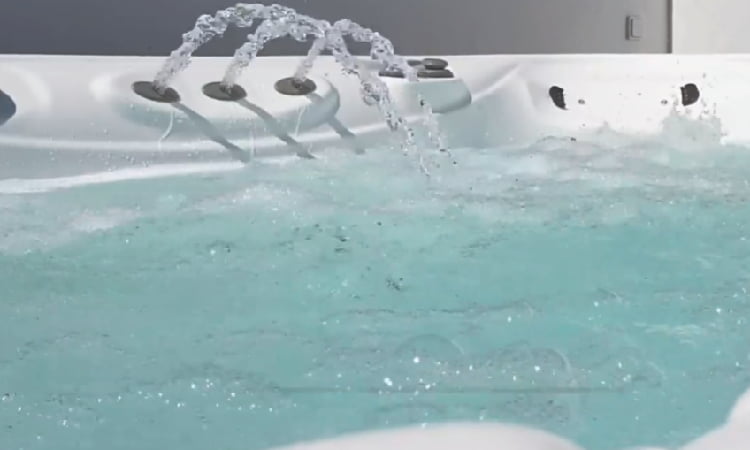
![What is a Stabilizer in a Hot Tub? [Types of Stabilizers] what is a stabilizer in hot tubs and how does it work](https://hottubtales.com/wp-content/uploads/2023/10/what-is-a-stabilizer-in-hot-tubs-and-how-does-it-work-250x150.jpg)
![Can You Over Shock a Hot Tub? [What to Do if You Did?] can you over shock a hot tub](https://hottubtales.com/wp-content/uploads/2023/10/can-you-over-shock-a-hot-tub-250x150.jpg)
